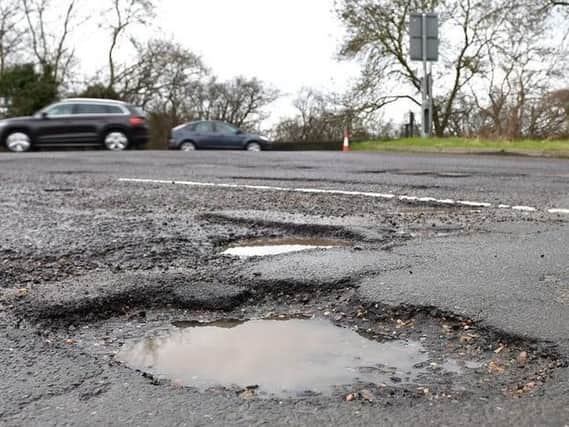It's costing £4.9bn a year repairing pothole damage to cars - and people would be willing to pay HIGHER taxes to fix the problem


And new research by Green Flag has revealed that potholes tops the list for 66 per cent, ahead of fast drivers (36 per cent), slow drivers (29 per cent) and lack of signposting (19 per cent).
With continuous changeable weather causing damage to UK roads the breakdown service has investigated the state of the worsening pothole epidemic across the nation, and found that UK drivers feel so frustrated by potholes, that two in five would be willing to pay more in tax or tolls for the luxury of driving on pothole-free roads.
Pothole Damage
Advertisement
Hide AdAdvertisement
Hide AdWith the majority (53 per cent) of UK motorists hitting the roads every day, the pothole epidemic has made drivers feel frustrated and digging further into their pockets to repair damage to their cars.
The research found that 56 per cent of UK motorists report their cars have been damaged by potholes, with a third (36 per cent) claiming they have experienced tyre damage and one in six (17 per cent) have faced suspension damage.
Spotting the Signs
Despite such high rates of pothole encounters and car repairs, only six per cent of UK drivers claimed to know all the symptoms of pothole damage to vehicle suspension, whilst a whopping 49 per cent said they wouldn’t be able to identify any symptoms of pothole damage. Only one third (34 per cent) think they’d be able to check tyres for signs of damage.
Money Spent
As a consequence, UK drivers are each spending almost £230 each per year on repairing car damage caused by potholes whilst a shocking two-fifths (42 per cent) spend in the region of between £100 and £200 per year. That equates to £4.9 billion spent by motorists on fixing pothole damage each year.
Advertisement
Hide AdAdvertisement
Hide AdThe research also found nine in 10 drivers (91 per cent) wish their council would do more to address the problem of potholes in their region. Although the Department of Transport recently announced they would commit £201 million** to tackle road maintenance, it falls far short of the estimated £9.79 bn it would cost to restore roads to good condition.
Increasing Tax
In fact, the pothole epidemic is frustrating drivers, to the extent that two fifths (40 per cent) of UK drivers said they would be willing to pay more car tax or road tolling for pothole-free roads, whilst more than a quarter (27 per cent) would be willing to add up to five miles to their journey in order to avoid a road with potholes.
Simon Henrick at Green Flag said: “The problem of potholes on UK roads means there is an increased risk of car damage. With this in mind, it is important to stay safe when driving and to regularly check your vehicle and tyres for damage.
“Our research found that only a third of drivers know how to check their tyres for damage, and only 49 per cent know how to change a tyre, so Green Flag is doing all we can to ensure drivers know how to carry out basic safety checks before a journey and carry out simple maintenance to their vehicles.”
Advertisement
Hide AdAdvertisement
Hide AdIn order to stay safe whilst driving on the roads, Green Flag has issued the following guide for changing a tyre:
How to change a tyre
Find a safe place to stop: As soon as you notice you have a flat tyre, find a safe place to stop off the road on a stable, flat surface. If you’re on a motorway, move to the hard shoulder and wait for assistance as it’s too dangerous to change a tyre there
Safety first: Put on a high visibility vest and place a reflective hazard warning triangle plenty of distance behind your car to alert oncoming traffic
Prepare for the job: Locate the spare wheel, the jack, wheel brace and locking wheel nut key. All should be either under the boot floor, under the car or in some SUVs on the back door
Advertisement
Hide AdAdvertisement
Hide AdNo spare? If you can’t find a spare wheel, your car may instead be equipped with mousse that can be squirted into the tyre through the valve. This is only a temporary solution to get you home and you should get the tyre changed as soon as possible
Prepare the wheel: To remove the punctured wheel and tyre, loosen the wheel nuts with the wheel wrench, but don’t remove them yet. If you can’t see the wheel nuts, you may have to prise off a cover first. If your car has alloy wheels, one of the nuts is likely to be locking and there will be a key that fits the wheel brace to undo this
Position the car: Check the handbrake is firmly on and put the car into first gear. Find the jacking point by looking in your car’s manual, and use the jack to raise the car so that the wheel with the punctured tyre is off the ground
Remove the wheel: Now fully remove the wheel nuts and take off the wheel. If the wheel won’t budge, call your breakdown provider: pushing and pulling it could bring the car off the jack
Advertisement
Hide AdAdvertisement
Hide AdAdd the spare wheel: Lift the spare wheel onto the hub, line up the holes and screw in the nuts until they’re finger tight. Once it’s secure, lower the jack and use the wrench to tighten the wheel nuts fully
To remember:
Check them all twice to be sure none is loose. Remember if your car has a space saver spare wheel, your top speed and the number of miles you cover is limited.
For more information about how to make sure your car is road ready visit www.greenflag.com